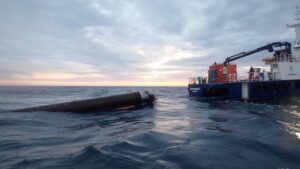Rocket Lab to make second booster recovery attempt
By Jeff Foust

WASHINGTON — The next launch of Rocket Lab’s Electron rocket will be the second mission where the company attempts to recover the vehicle’s first stage as part of its efforts to reuse the booster.
An Electron rocket is scheduled to launch no earlier than 6 a.m. Eastern May 15 from Rocket Lab’s Launch Complex 1 in New Zealand. It will place into orbit two imaging satellites for BlackSky in the first of four dedicated missions arranged through launch services company Spaceflight earlier this year.
As with a November 2020 launch, the Electron’s first stage will reenter and splash down in the Pacific Ocean several hundred kilometers downrange from the launch site. A ship will retrieve the stage from the water and return it to the company’s factory for analysis.
One change from the previous recovery attempt is a new heat shield at the base of the rocket, Rocket Lab Chief Executive Peter Beck said in a May 11 call with reporters. The rocket previously had an aluminum-backed shield intended to cover heat loads experienced during ascent only.
The rocket now has a stainless-steel heat shield, covered with thermal protection material. “It’s very much designed to carry the reentry loads as well as the ascent loads now,” Beck said.
This rocket will also reuse components of the “propellant press” system that flew on the Electron last November. Beck described that as a helium pressurization system to pressurize the rocket’s kerosene and liquid oxygen propellant tanks, and includes pressure vessels, valves and related plumbing.
“The press system is a great candidate to start with because it’s a very easy system to isolate and test quickly,” he said. The company also removed other components of the stage, such as its avionics system, and tested them in the lab but won’t refly them on this vehicle.
Rocket Lab plans one more upgrade of the Electron first stage as part of its reusability efforts, to be tested on a launch before the end of the year. That upgrade will feature a deployable decelerator intended to reduce the heat load on the stage by a factor of 10. He declined to discuss the technical details of that decelerator, but said it’s designed “to really deal with heat loads in a much more aggressive way.”
“If we can remove the heat loads, it gives us a lot of more tolerance on the reentry corridor,” he said. “It just gives us a ton of margin on the thermal side.”
Rocket Lab ultimately plans to recover the Electron boosters in midair, using a helicopter, but during the testing phase of the program will allow the boosters to splash down. “Logistically, it’s pretty easy for us to do these ocean splashdowns,” Beck said. “The approach here is to just keep splashing them down until we put one back on the boat where we say, yes, this is really incredible.”
That midair recovery, he said, remains a part of the company’s long-term plans, and is essential to the reuse of the booster. While there have been internal discussions at Rocket Lab about reflying boosters that splash down, Beck said concerns about how the exposure to salt water could affect components like avionics and their connectors make it unlikely it will refly any boosters that do end up in the water.
“Our number-one focus is on mission assurance and mission reliability,” he said. “None of the avionics was originally designed to go for a swim.”
None of the company’s customers, Beck said, have raised any concerns about flying on a reused booster. “The vehicle that we put on the pad that’s reused will have the same level of mission assurance and certification as a brand-new one,” he said. “We won’t be taking any risks there.”
He added there’s a “huge amount of work going on in the background” about determining how many times a booster can fly. He noted the addition of the decelerator on the next upgrade of the booster will ensure vehicle elements stay well away from any temperature limits that might affect their lifetime.
Tests of the rocket’s Rutherford engines suggest that they could be reused many times, he noted. “The lifetime of many of the elements are very, very long,” he said. “It wasn’t necessarily intended by design. It’s just that, if you build something very robustly from day one, then that’s kind of the happy consequence.”
May 14, 2021 at 04:34PM
via SpaceNews read more...

Post a Comment